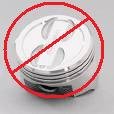Hello, I have a 1971 35' Lyman Express Cruiser which came with a par of Chris Craft 350Q engines rated at 325 horsepower. I am restoring the boat and I pulled then engines. While I have them out I figure I will rebuild them. I would like to get some more power out of the engines since I think 235 is pretty low for the boat. Crusader currently offers a carburated 350 rated at 315 horsepower so I figure using a few tweeks I can at least achieve that. I also considered rebuilding it as a 383 stroker. However, this boat being a cruiser I am more interested in fuel economy and range rather than acceleration and top speed so I am not sure which route would better suit the boat. The boat weighs about 13000 LBS and should have a top speed of about 35 kts according to the factory literature. The current engine is the 235 HP 350Q turining a 19X19 three blade prop. Any suggestions or comments on the rebuild/repower would be greatly appreciated.
Regards,
Mike
Regards,
Mike


